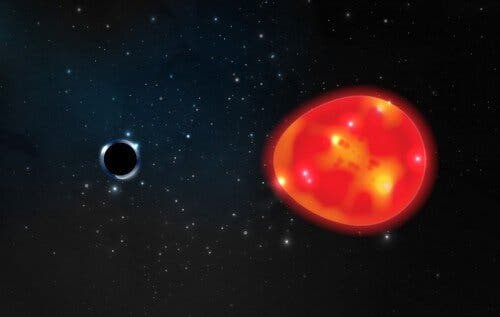
Nestled between a myriad of stars inside the constellation Monoceros, researchers have found a tiny black hole hiding in plain sight. The cosmic object is just 1,500 light-years away, making it the closest black hole to home found thus far. Its mass is just three times that of the Sun, something that scientists didn’t even think possible until not too long ago. Due to this combination of unique factors, the closeby black hole was aptly dubbed ‘The Unicorn.
An invisible unicorn
Black holes are some of the most mysterious and elusive objects in the cosmos. Black holes usually form when a large star dies and collapses into itself, generating a singularity whose gravitational field is so powerful that not even light can escape its clutches.
Since black holes are essentially one-way doors into the universe, anyone visiting them is banished forever, never to return to tell the tale. That’s a frightening way of saying black holes are invisible to our direct observations, although since 2019 scientists have made a huge breakthrough by imaging a black hole’s event horizon for the first time — the boundary beyond which light can’t escape, but where matter congregates and emits radiation as it gets gobbled up by the voracious black hole.
Most of the black holes known to science have been discovered indirectly, typically due to their interaction with a companion star, which leads to the generation of a lot of X-rays that are actually visible to our instruments.
But the story of how The Unicorn was discovered is, of course, different. Astronomers at Ohio State University looked at data for observations of the black hole’s companion star documented by three telescope systems, including KELT, ASAS, and NASA’s TESS satellite that is on a mission to find exoplanets.
When Tharindu Jayasinghe, a doctoral student in astronomy at The Ohio State University, had a first look at this data, he noticed something odd. The red giant changed in intensity and appearance at various points around the orbit, suggesting it had a companion.
Just like the moon’s gravity is tugging at the Earth, producing high tides, so did this hitherto unidentified object distort the star into a football-like shape, with one axis longer than the other.
“When we looked at the data, this black hole—the Unicorn—just popped out,” said Jayasinghe, who is the lead author of the new study published in the journal Monthly Notices of the Royal Astronomical Society.
Based on the pulling effect incurred by the red giant, known as tidal distortion, as well as the velocity and period of orbit of the star, the astronomers calculated the black hole is about three solar masses.
Any black hole candidate less than five times the mass of the sun falls into a size window that astronomers call the “mass gap”. Although Einstein’s equations from his theory of relativity show that a leftover core from a dying star can turn into a black hole if its mass is at least three times as massive as the sun, scientists didn’t have confirmation that such a tiny black hole existed until very recently.
“When you look in a different way, which is what we’re doing, you find different things,” said Kris Stanek, study co-author, an astronomy professor at Ohio State. “Tharindu looked at this thing that so many other people had looked at and instead of dismissing the possibility that it could be a black hole, he said, ‘Well, what if it could be a black hole?'”
In the future, as more large-scale space experiments are set up, astronomers expect to encounter more such smaller black holes of this calibre. Perhaps The Unicorn isn’t that special after all.
“I think the field is pushing toward this, to really map out how many low-mass, how many intermediate-mass and how many high-mass black holes there are, because every time you find one it gives you a clue about which stars collapse, which explode and which are in between,” said Todd Thompson, co-author of the study, chair of Ohio State’s astronomy department.






